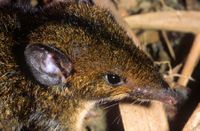If you cannot find the answer you are looking for, please contact us.
Hainan gymnure

First described in 1959, the Hainan Gymnure was long considered part of the Hylomys genus, but genetic studies have confirmed it deserves its own genus, Neohylomys.
Taxonomy
| Kingdom: | Animalia |
| Phylum: | Chordata |
| Class: | Mammalia |
| Order: | Eulipotyphla |
| Family: | Erinaceidae |
| Subfamily: | Galericinae |
| Genus: | Neohylomys |
| Species: | Neohylomys hainanensis |
Not a ‘real’ hedgehog
The Hainan Gymnure shares family ties with hedgehogs and shares traits like nocturnality, insectivory, and a keen sense of smell. Still, it lacks spines, cannot curl defensively, and sports soft fur instead. Its elongated snout, furtive movements, and resemblance to shrews make it clearly different from spiny hedgehogs, though it remains a close evolutionary relative.
Natural range & habitat
This species exists only on Hainan Island, China, and was recently also found in northern Vietnam. It occupies tropical dry and montane forests, including fragmented or secondary forests, often near streams, shrubland, and rocky or woody debris. Its distribution spans low to high altitudes of the island, but habitat loss threatens its limited range.
Physical traits
With a body length between 12 and 14.7 cm and a relatively long tail (about 3.6 to 4.3 cm, around 30% of body length), it weighs between 50 and 70 g. Its fur is reddish-brown with a distinct black dorsal stripe, and paler underparts. The tail, ears, and feet are nearly hairless, and the snout is long and flexible, features well suited to probing soil and forest litter.
Behavior & lifestyle
Primarily nocturnal or crepuscular, this gymnure forages along the forest floor and uses burrows or dense underbrush for daytime refuge. It was once thought to be subterranean, but current evidence suggests burrows serve refuge rather than foraging. It relies on speed, scent, and stealth, not defensive spines, to evade predators.
Communication
Details are lacking, but like related species, it likely uses scent marking and possibly quiet vocalizations to communicate. Its heightened sense of smell is probably well suited for both territorial signaling and navigating its environment.
Diet in the wild
It feeds primarily on insects and earthworms, using its agile snout to probe leaf litter. Its ecological role is likely as a ground-foraging insectivore, though dietary specifics remain unstudied.
Reproduction & life cycle
Little is known. Insights from related gymnure species suggest a small litter size born altricial, though breeding season and life cycle details remain undocumented.
Threats & conservation status
The Hainan Gymnure is listed as Endangered due to its extremely limited range and severe habitat loss from deforestation and agricultural encroachment. There are no known population estimates, and conservation requires urgent habitat protection.
This species in captivity
There are no known records of the Hainan Gymnure in captivity. Its rarity, secretive habits, and specific habitat needs make captive maintenance unfeasible. Conservation must focus on in situ protection.
